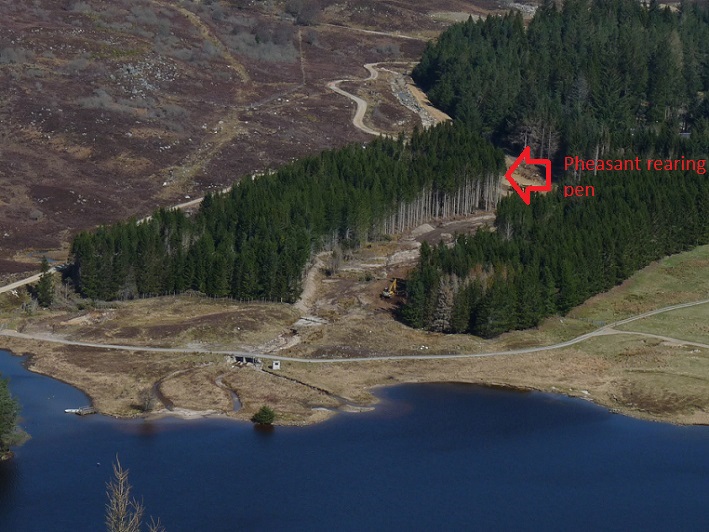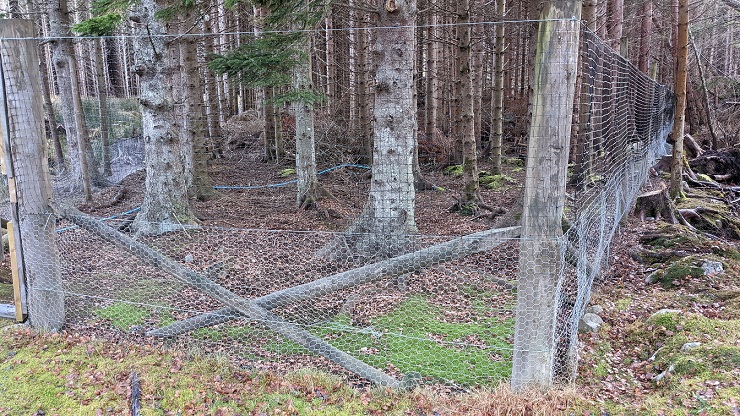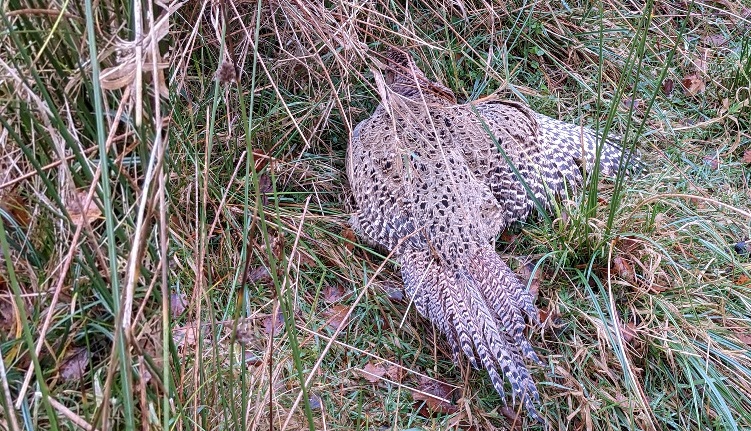
On 28th June Raptor Persecution UK published a press release from Police Scotland appealing for information after a goshawk nest near Loch Gynack on the Pitmain Estate had been abandoned, apparently after a shot gun attack (see here). While no-one has yet been charged, this post will argue this was an “incident” waiting to happen and shows up yet more flaws in the Wildlife Management and Muirburn (Scotland) Act 2024.
120 years ago the goshawk was probably extinct in the UK, a consequence of relentless persecution and pesticides. We owe its re-introduction not to the efforts of conservation organisations but to falconers. As a result a number of escapes, whether deliberate or not, goshawk re-wilded, slowly expanded their range and in the last fifteen years have become increasingly common in the Grampian area, including the Cairngorms National Park. (A similar process enabled captive beavers to recolonise the Tay catchment).
Goshawks are raptors of woodland, not open country, hunt under the tree canopy and favour coniferous woodland. Just as hen harriers will take a lot of grouse, where numbers have been artificially inflated through intensive moorland management, goshawk (particularly the larger female) will take a lot of pheasant, where these have been reared for shooting purposes.

Ten years ago research (see here) showed that almost seven times more pheasant than grouse were shot in the Cairngorms National Park and pheasant and partridge shooting were also a more import source of revenue (if not prestige) for sporting estates:

It should have been quite predictable that as goshawk started to colonise the woodland used for pheasant rearing and shooting they would be persecuted. From a sporting estates perspective the fact that goshawk kill pheasant, an introduced species, is far more significant than the fact that they predate corvids, which they allege are responsible for the decline of many other species, and help keep their populations under control.

Most of the Pitmain sporting estate was historically managed for deer stalking and grouse shooting but more recently it has diversified and rears large numbers of both red-legged partridge and pheasant. These birds are now everywhere around Loch Gynack – I counted dozens of pheasant earlier this year – and it should come as a surprise to no-one that goshawk tried to nest by the loch given the copious source of food.
Equally, it should come as no surprise that someone decided to get rid of them alhough, just as with every other case of raptor persecution, proving who did it is likely to be an unsurmountable task.
It was precisely because raptor persecution is so difficult to prove that after years of effort by campaigners, the Scottish Government was forced to introduce a grouse moor licensing scheme earlier this year. That is now due to come into operation before this year’s grouse shooting season (see here). Parkswatch has argued that the licensing scheme was always very weak and unlikely to make much of a difference (see here) and that view has now been confirmed by NatureScot advertising for just 6 new licensing officers, three of them temporary, to manage the scheme (see here):

The primary function of the new licensing officer posts appears to be processing paperwork. There is absolutely no way that on top of those requirements three junior staff will be able to monitor sporting estates adherence to the scheme from next year .
What the Gynack goshawk case reveals is another gaping hole in the Wildlife Management and Muirburn Act when it comes to raptor persecution by sporting estates. The licensing scheme at present only applies to grouse and to areas where grouse shooting takes place. This won’t make one iota of a difference to the protection of goshawk and sparrowhawk which hunt in woodland. While in theory it could be extended, the Act contains no means for assembling the evidence that might inform such a decision: while Scottish Ministers have to report each year on the number of moorland raptors which are unlawfully killed – peregrine, golden eagle, hen harrier and merlin – there is no provision to report on the persecution of other raptors like goshawk, sparrowhawk, red kite or sea eagles.
That gaping hole in the legislation is likely to become ever more significant for two reasons. First a number of sporting estates, such as Pitmain, appear to be turning away from grouse because there are not enough to feed their shooting appetites. Second, there is a strong financial incentive to increase woodland cover for carbon-offsetting processes, a process being encouraged by the Cairngorms National Park.
Two weeks ago, the Highland Green MSP, Ariane Burgess, made a valiant attempt in the Scottish Parliament to strengthen the weak measures in the Wildlife and Muirburn (Scotland) Act 2024 by introducing three amendments to the Agriculture and Rural Communities (Scotland) Bill at its final reading. The amendments (no 37, 38 and 39 – see here) would have allowed – not required – Scottish Ministers to:
1) rule out specific land uses (such as sport shooting) from getting agricultural subsidies in the future
2) end public funding for estates where the primary activity on the land is driven grouse shooting
3) ensure that wildlife criminals and irresponsible owners cannot benefit from public funding, including recovery of public grants where someone had been found guilty of a wildlife crime.
Had these amendments been passed and someone from the Pitmain Estate been found guilty of destroying that goshawk nest, that would have would have allowed the Scottish Government to recover grants they had handed out to the estate in past, including:

Grant clawback might have acted as a real incentive to the managers of Pitmain to ensure that no-one with a shotgun got anywhere near the goshawk nest. Unfortunately, Ariane Burgess was only supported by her own party and Labour, with the SNP and the Tories voting her amendments down.
Given the SNP and Scottish Government’s unwillingness to tackle the multiple problems caused by sporting estates, the Cairngorms National Park Authority is in a very weak position. It could still, however, challenge the Scottish Government to deal with these problems at source and support a ban on the import of non-native game birds, like pheasant and red legged partridge, into the National Park. The CNPA’s National park Partnership Plan commits the CNPA to look into this – eventually! It plans to establish how many gamebirds are actually being introduced to the National Park by 2027. How many more goshawk will have been unlawfully killed or had their nests destroyed by then?
Instead of dealing with the real problems caused by land-managers, the CNPA is more interested in trying to control outdoor recreation, as evidenced by the agreement of its Board last week to introduce byelaws to ban camp fires (see here) but NOT the extensive muirburn that will continue in the National Park as a result of the hopeless Wildlife Management and Muirburn (Scotland) Act!

Four years ago evidence suggested the Pitmain gamekeepers were persecuting Peregrines that were attempting to nest above Loch Gynack. The Peregrines have not attempted to nest there since then. It should come as no surprise if the estate is persecuting Goshawks. I have seen Goshawks hunting Pheasants several times in the release pens that the estate uses for young birds.
Just another thought are the Wildcats currently being released locally to Pitmain safe from gamekeepers? ( I know of a keeper in the Loch Ness area who shot and trapped many Wildcats in the 1970s when they were still relatively common in that area.) Has the Wildcat release project negotiated with local estates in Strathspey to avoid keepers killing Wildcats? SadlyI have doubts that keepers will not kill Wildcats, just another “vermin” species to them.
‘proving who did it is likely to be an unsurmountable task’?
To be effective, they have to keep doing it, year after year. You only have to catch them once.
How about requiring estates, as a condition of licencing, to pay for surveillance measures where there is evidence that unknown persons have committed a crime?
Yet another example of ‘window-dressing’ by our Scottish Parliament, aided and abetted by NatureScot which clearly doesn’t want to step out of line.
It is truly incredible that private landowners are allowed to release so many non native species into the natural environment without some form of permission (in or out of a national park). Shooting birds brought up in cages and fed in pens is also a sad and pitiful way to find your fun. 99% of the birds that are shot are not eaten by humans. The bodies are either left, buried or otherwise destroyed. Some rich human beings sadly pay big money for the pleasure of killing.